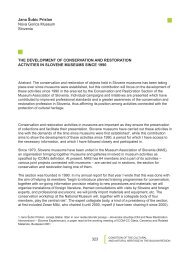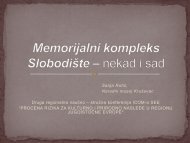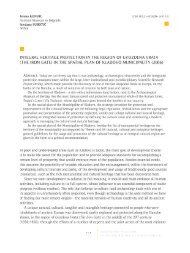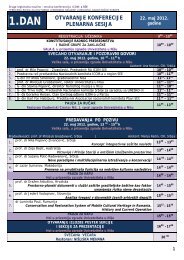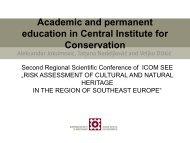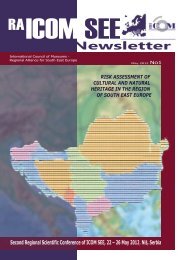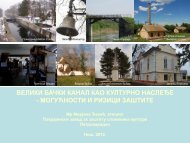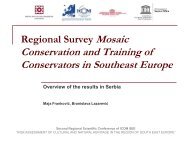67 Anica Gorgievska Institute and Museum – Bitola ... - ICOM-SEE
67 Anica Gorgievska Institute and Museum – Bitola ... - ICOM-SEE
67 Anica Gorgievska Institute and Museum – Bitola ... - ICOM-SEE
Create successful ePaper yourself
Turn your PDF publications into a flip-book with our unique Google optimized e-Paper software.
As a city with multiple century tradition, it has the necessary objects that mark that feature <strong>–</strong><br />
Thermae, Portico of the Court Room that has very sophisticated look with the verses by Hesoid<br />
(performed in his book “Works <strong>and</strong> Days”, dedicated to the Zeus <strong>and</strong> Justicia) as well as the<br />
impressive theater. These are all indicators that the life had very high cultural dimension<br />
throughout the centuries (picture 1).<br />
The most famous period of Heraclea was during the establishment of Christianity as a state<br />
religion when the city becomes the headquarters of the episcopacy. This is evident from the<br />
mentioning of the bishops about their participation on the church Events.<br />
The look of the city acquires Christian features with all typical buildings. This is evident from the<br />
beautiful architectural buildings <strong>–</strong> the Small Basilisk, the Great Basilisk, the Episcopal Residence<br />
with numerous mosaics <strong>and</strong> the Central City Fountain erected on the occasion of 35 years of rule<br />
by the very energetic Emperor <strong>–</strong> Justinian.<br />
The episcopes from Heraclea in the IV-VI century AC are mentioned not only in the community but also<br />
on the Ecumenical Councils, even sometimes they are mentioned as deputies of the Episcope from<br />
Salonika. This means that Heraclea, as Episcopal Center has important role for the overall religion.<br />
The urban life in Heraclea diminishes at the end of VI century with the attacks by the Slavs <strong>and</strong> Avarians.<br />
What is the most brilliant, most impressive, most mysterious <strong>and</strong> definitely most important in<br />
Hearclea Lyncestis are the floor mosaics.<br />
There is no doubt that the Heraclea mosaics are the product of early Christian times <strong>and</strong> they are<br />
the mark of the Christian soul. Each <strong>and</strong> every period of civilization creates its unique art <strong>and</strong> the<br />
mosaics are very good proof. Thanks to these mosaics we have an insight into the life of the early<br />
Christianity where we see “holy arts”, sincere, untouched, captivating…<br />
The circle of same motives repeats on these floors so these are classified into four groups where it<br />
is possible to recognize four elements, the four areas of the Christianity universe 2 ;<br />
1. The symmetric pictures represent the Holy Heaven <strong>–</strong> the most holy area in the Christianity<br />
universe <strong>–</strong> the place of God.<br />
2. The trees with fruits, birds, flowers, tranquil animals <strong>–</strong> are all part of the pictures of heaven/ the<br />
second area of the Christianity universe.<br />
3. Animals fight <strong>–</strong> those that chase them <strong>and</strong> those being chased mark the Earth <strong>–</strong> the third area,<br />
<strong>and</strong><br />
4. The water l<strong>and</strong>scape i.e. pictures with waters full of fish <strong>and</strong> other sea, river, real <strong>and</strong> imaginary<br />
creatures is the fourth <strong>and</strong> final area of the cosmos.<br />
All mosaics in Heraclea have unique beauty but the master piece of the early Christian art is the<br />
mosaic on the floor of the Great Basilica Nartex.<br />
The creator of the Heraclea mosaic used over 100m2 to create a “rhythmical composition” with a<br />
tendency towards symphonic principal: ideal balance <strong>and</strong> beauty with great aesthetic value, strong<br />
feelings of tranquility <strong>and</strong> elegance against the expressed dynamics <strong>and</strong> quivering (picture 2).<br />
2<br />
Tomasevic <strong>–</strong> Cvetkovic “Early Christian Floor Mosiacs in the Episcopal floor in Heraclea Lyncestis, Belgrade, 2002<br />
68 [<br />
CONDITION OF THE CULTURAL<br />
AND NATURAL HERITAGE IN THE BALKAN REGION





